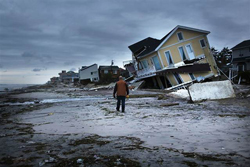In the last few weeks, a new page was written in the history books of the Jersey Shore, marked under the shadows of wreckage and havoc from the aftermath of Hurricane Sandy.
Though only a category one hurricane, Sandy devastated the homes of tens of thousands of people in the tri-state area, leaving unprecedented damage Superstorm Sandy’s Unprecedented Impact across the shorefronts.
Atlantic City, known for its boardwalk, beaches, and blackjack, became an extension of the Atlantic Ocean as seaweed and debris circulated the kneedeep murky water, covering the shorefront streets and beyond. The property damage there was pretty extensive, according to Mayor Lorenzo Langford who said in an article in CNN, “I’m happy to report that the human damage, if you will, has been minimal.”
Governor Christie said he saw the damage left behind by Hurricane Sandy as “overwhelming” according to CNN.
“We will rebuild it. No question in my mind, we’ll rebuild it,” Christie said. “But for those of us who are my age, it won’t be the same. It will be different because many of the iconic things that made it what it was are now gone and washed in to the ocean.”
“I think many of us underestimated the damage this storm would cause,” said Paula Burns-Ricciardi, history professor. In all my years, I have never seen a storm of this magnitude followed within days by a snowstorm and I am heartsick over the damage Sandy has done to so many people and to our treasured landscape. I am impressed, however, at how this tragic event has moved people to come together to help one another.”
Eight million people across the Mid-Atlantic and New England states, according to CBS, were left without power, leaving many facing dire situations in the searing cold winds following the storm. The elderly especially, many of whom require medical equipment that uses electricity, were left trapped in high-rise buildings with no-power.
At the latest count, officials had attributed more than 100 deaths to Hurricane Sandy, more than half of whom were elderly residents aged 65 or older. Many of those who passed away in coastal neighborhoods “perished at the height of the storm, drowned by the surge,” according to New York Times.
Going more inland, falling trees from a brutal beating by the hurricane’s relentless winds posed a more recurring cause of death, as people looked for gas for their cars amongst ghost-town gas stations and left their homes to clear off debris to start their generators.
Combined with coastal flooding and the sharp cold front, those living in homes without heat or electricity faced the danger of hypothermia, a condition where the core body temperature falls below that needed for normal metabolic activity. In the aftermath of Hurricane Sandy, an unidentified resident of Long Branch was found dead of hypothermia. He was “wrapped up in blankets and there was no electricity in his home,” according to the New York Times.
As of November 21, the Federal Emergency Management Agency (FEMA) has authorized $844 million and deployed 7,622 FEMA personnel to provide “support response operations, including search and rescue, situational awareness, communications and logistical support” for the 453,318 registered people awaiting assistance, according to fema.gov.
A hurricane is a tropical cyclone, comprising a rotating weather system spreading over tropical oceanic regions. It is typically accompanied by thunderstorms and by a counterclockwise circulation of winds in the Northern Hemisphere. According to Forbes, the 900 mile wide Hurricane Sandy launched its storm surge at moon tide, the highest possible high tide, and merged with another storm system, causing Sandy to become the unprecedented storm meteorologists had warned of.
The totality of damage left by Sandy’s wake was estimated at $30- $50 billion. The losses which have continually been piling higher and higher have put the costs of Hurricane Sandy above many of the hurricanes that have struck the US, and even on par with Hurricane Andrew in 1992 said Kenneth Rapoza of Forbes.
Jonas Colmer, fourth year chemistry major at the University, said, “Despite the traumatic events that have occurred on the shore, I am amazed by the sense of community our towns have demonstrated over the last month. Every day we are making great progress in rebuilding because of our willingness and kind heartedness to help our fellow neighbors when they need it the most.”
IMAGE TAKEN from causecast.com



